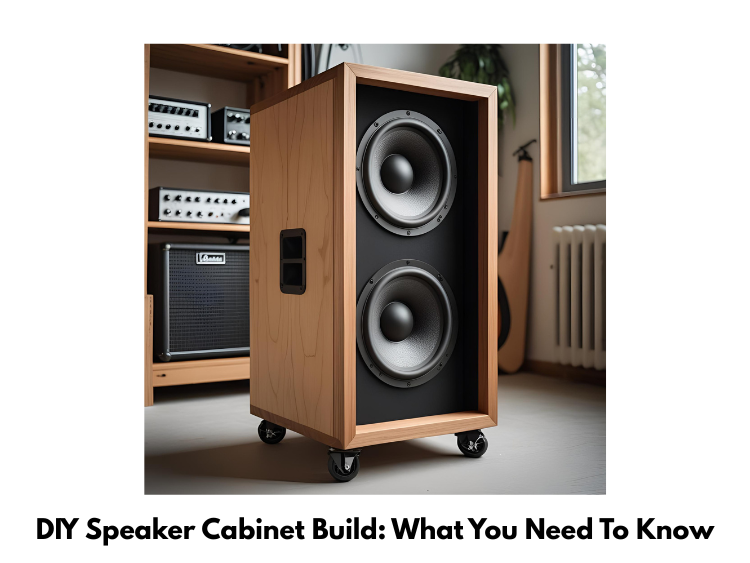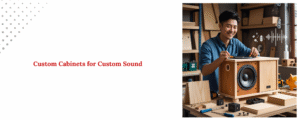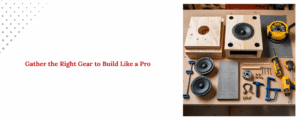Building your own speaker box is a great way to enjoy making things for people who love music and sound. It can save you money and let you change the way it looks, sounds, and is sized however you want. First, learn the basics. This is true whether you’re making a guitar amp, a bass box, or a high-end home speaker. You can read this article and learn everything you need to know before you start.
Why Make Your Own Cabinet for Speakers?
There are a few main perks to making your own speaker cabinets:
- Customization: Pick the materials, sizes, and looks that you want.
- Cost savings: High-end cabinets can be pricey. If you build your own, you can save a lot of money.
- Custom Sound Tuning: You have complete control over the sound design, making it work best for your drivers and personal sound tastes.
- Feeling good: There’s nothing better than using a box you built yourself to play or listen to music.
If you’re still deciding on the best driver, check out this guide to the best raw replacement speakers in 2025.
Important Planning Before You Begin
1. Write Down Your Goal
What kind of cabinet do you have? A bass setup? A radio for the house? Different design decisions need to be made for each reason.
- People who play guitar often choose open-back speakers because they sound fuller and more open.
- Most of the time, bass cabinets need to be sealed or ported to get a tight, sharp low end.
- To get clarity and sound balance, home audio speakers need to be carefully engineered.
If you’re building for home use, read about the best replacement speakers for home audio.
2. Pick the Correct Speaker Drivers
A lot of what your cabinet sounds like depends on the drivers. Carefully look into the specs of your drivers:
- Ohms of impedance
- Power handling (watts)
- Frequency response range
- Size (10”, 12”, 15”, etc.)
Make sure that the driver you choose works with the output of your speaker.
3. Choose the Type of Cabinet
There are a few main types of cabinets:
- Sealed (acoustic suspension): Sound that is tight and clear. Great for bass and clarity.
- Ported (bass reflex): It’s louder and works better, especially for lower sounds.
- Open-back: Sound is lighter and less focused; commonly used in guitar amplifiers
Each style requires a different design approach. If you’re looking to replace car speakers instead, see the top 5 car replacement speakers.
The Things and Tools You’ll Need
Materials:
- Good plywood—birch is the best choice for tone and longevity
- Driver(s) for speakers
- Wood glue and screws
- Soundproofing or softening material
- Speaker grille cloth
- Handle, corner guards, and feet (especially for playing cabs)
Tools:
- Circular saw or table saw
- Power drill
- Jigsaw (to cut the hole for the speaker)
- Clamps
- Tape measure
- Soldering iron (for speaker wiring)
Using high-quality materials, especially birch, will greatly improve both the sound and durability of your cabinet.
Important Building Tips
1. Get Your Measurements Right
As the saying goes, “measure twice, cut once.” Simply misaligning the speakers can weaken the box and reduce clarity. Every panel should fit snugly.
2. Joints That Are Tight and Don’t Leak Air
An airtight enclosure is critical for sealed or ported designs. Apply wood glue liberally at all joints and reinforce with screws. Even minor leaks can reduce bass performance.
3. Bracing on the Inside
Internal bracing reduces vibration and flexing, which can color the sound, especially in larger cabinets. Use wooden strips between walls for simple yet effective support.
4. Dealing with Noise
Lining the inside with foam, fiberglass, or acoustic stuffing reduces internal reflections and standing waves, improving overall clarity.
5. Placement of the Port
In ported cabinets, the size and placement of ports are vital. Use round tubes or square slots. Refer to online calculators based on your driver’s Thiele/Small parameters to get it right.
Setting Up Your Speaker
When connecting your speaker:
- Use the proper gauge wire (16 or 18 gauge is typical).
- Maintain correct polarity—reversed wiring can cause phase issues.
- If soldering isn’t an option, use secure push terminals.
- For multi-driver setups (like a 2×12″ cab), choose the right wiring method (series, parallel, or series-parallel) to achieve the desired total impedance.
Last Thoughts
Making your own speaker box is a fun project that mixes woodworking, electronics, and sound science. Even though you have to be patient and careful, the reward is huge. You’ll end up with a one-of-a-kind box that’s perfect for your sound, style, and budget.



